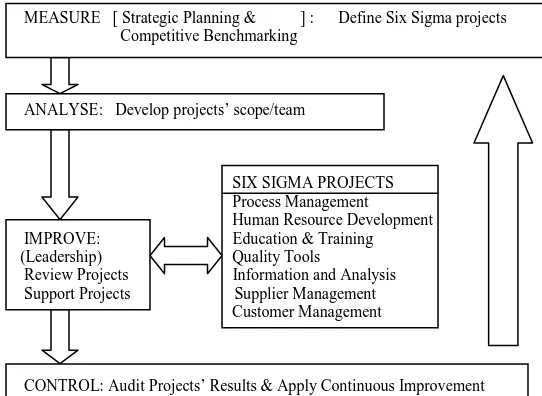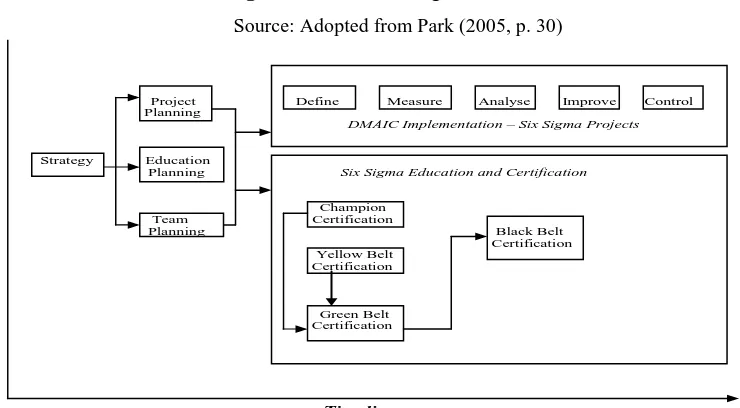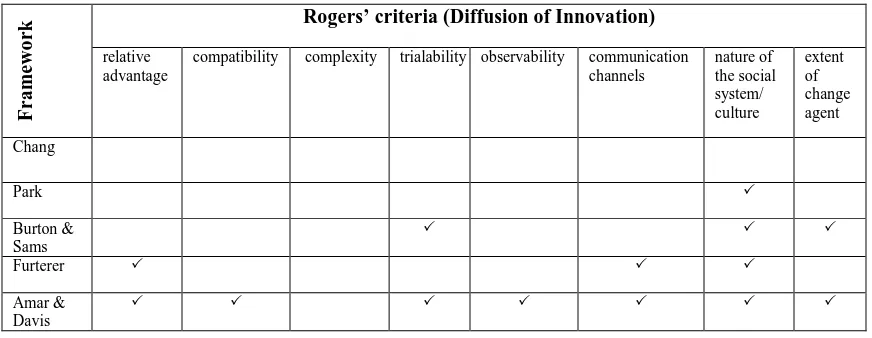35
SIX SIGMA FRAMEWORKS: AN ANALYSIS BASED ON
ROGERS’ DIFFUSION OF INNOVATION THEORY
Kifayah Amar1
Abstrak: This paper attempt to analyze frameworks related to Six Sigma and Lean Six Sigma. The basis of analysis the frameworks is the diffusion of innovation theory. Several criteria was used to analyze the frameworks e.g. relative advantage, compatibility, complexity, trialability, observability, communication channels, nature of the social system/culture and extent of change agent. Based on framework analysis, there is only one framework fits to Rogers’ theory on diffusion of innovation. The framework is a Lean Six Sigma framework which consists elements such owner/manager commitment and involvement, employee involvement, training, culture change and external support. Even though the elements have similarity to other Six Sigma frameworks but they put more attention on culture change and external support. Generally speaking, the culture change and external support are the most important elements to the implementation of Six Sigma or other soft approaches particularly for small organizations.
Keywords: Critical Success Factors, Six Sigma, SME
INTRODUCTION
Six Sigma as TQM concept has a strong customer focus, and contains key concepts related to strategy, organizational change, training and setting stretch objectives (Evans & Lindsay, 2005). The central idea of the six sigma approach is to design processes, or improve existing processes, to obtain very high process capability and hence defect rates that are close to zero. This concept was first introduced by Motorola Company in the mid 1980s. After several years, many researchers or organizations combines Six Sigma with other improvement programs such as Lean Manufacturing.
The majority of Six Sigma implementation found in large manufacturing organizations. Nowadays, this concept is also found implemented in service and government sectors. However, it can be said that organizations implemented this concepts are still dominated by large organizations which have good resource and technology in place.
To implement the six sigma concept, an implementation framework is needed to provide guidance in particular if the organizations are limited in fund. After extensive investigations from literatures, particularly from Six Sigma and quality management journals, there are few frameworks developed by international researchers to implement Six Sigma focused on both large and small organizations. The Six Sigma and Lean Six Sigma frameworks/models along with the analysis based on Diffusion of Innovation Theory will be discussed in the following sections.
1Industrial Engineering Department, Faculty of Science and Technology,
UIN Sunan Kalijaga, Jl. Adi Sucipto no. 1A, Yogyakarta Email: [email protected]
36
SIX SIGMA AND LEAN SIX SIGMA FRAMEWORKS/MODELS
There are three frameworks for implementing Six Sigma has been found in the literatures (Chang, 2002; Park, 2005; Burton & Sams, 2005), and two frameworks for implementing Lean Six Sigma (Amar & Davis, 2010; Furterer, 2004). They are briefly described below.
Chang developed his framework mainly based on MBNQA (Malcolm Baldrige National Quality Award) model which contained TQM elements such as strategic planning, leadership, process management, human resource, education and training, quality tools, customer management, supplier management and information and analysis. He claimed those elements as critical factors for SMEs to adopt Six Sigma and assembled them into his framework follow the MAIC (measure-analyse-improve-control) steps. The weakness of Chang’s framework is no discussion about culture or consideration on limitations of SMEs when he developed his framework. He did not explain how to bring these factors into implementation. For instance, education and training under Six Sigma projects, he did not suggest what the best training type for SME. The SME may be impossible to follow the common training scheme of Six Sigma (green belt, black belt, etc.) because they have limitation in fund.
MEASURE [ Strategic Planning & ] : Define Six Sigma projects Competitive Benchmarking
ANALYSE: Develop projects’ scope/team
SIX SIGMA PROJECTS Process Management Human Resource Development IMPROVE: Education & Training (Leadership) Quality Tools
Review Projects Information and Analysis Support Projects Supplier Management Customer Management
CONTROL: Audit Projects’ Results & Apply Continuous Improvement
Figure 1. Six Sigma framework for SMEs
Source: Adopted from Chang (2002, p. 152)
Another framework, developed by Park (2005), is believed to be more suitable to large organizations. However, there is no explanation to justify of those elements are appropriate, since it is based on his experience as a consultant. It can be said that this is a generic model of Six Sigma and needs to change in a way to give a clear guidance to SMEs in implementing the concept.
37
Source: Adopted from Burton and Sams (2005, p. 38)
Burton and Sams’ framework, however, places education and certification as an important aspect for the Six Sigma teams. It can be argued that certification can not assure the success of Six Sigma implementation. The most important is Six Sigma teams should have enough understanding to use basic and advanced quality tools to solve organizational problems. It is not difficult task since these basic and advanced tools of Six Sigma are not new tools; they have used in the TQM or other improvement programs in the past.
38
framework. As found in several literatures, training is important and critical to the implementation of Lean Six Sigma and should be put as a factor in her framework.
Figure 4. Lean Six Sigma framework
Source: Adopted from Furterer (2004, p. 41)
Meanwhile, Amar and Davis (2010) have developed a Lean Six Sigma framework specifically for Indonesian SMEs context. The framework can be seen in Figure 5.
Figure 5. Lean Six Sigma framework for SMEs
Source: Adopted from Amar and Davis (2010, p. 190)
39
ANALYSIS OF THE SIX SIGMA AND LEAN SIX SIGMA FRAMEWORKS
The Rogers’ Theory emphasized on several variables which influences the adoption of innovation e.g. relative advantage, compatibility, less complexity, trialability, observability, communication channels, nature of the social system/culture and extent of change agent. Generally speaking, the innovation (it can be an approach or a concept) should consider the criteria in order to be successfully implemented.
The author will examine the existing frameworks using those criteria to determine the adoption success innovations. The examination is based on whether the authors/researchers of the previous studies have discussed or having similar thought to Rogers’ idea as presented below.
Table 1. Examination of existing frameworks based on Rogers’ idea on diffusion of innovation
compatibility complexity trialability observability communication channels Government or other parties related to SMEs, in order to support the implementation of new concept/approach. It is believed that the presence of change agent will help in cultural change of the organization. Meanwhile, the support from external will overcome the complexity of implementing the concept e.g training provision, consultation and etcetera.
CONCLUDING REMARKS
Examination of the existing frameworks using Rogers’ theory shows that almost no framework completely fits to Rogers’ idea. Amar and Davis’ framework seem to be the best framework among others and put attention on the need of external support and change agent. The framework consists of important elements such as owner/manager commitment and involvement, employee involvement, training, culture change and external support.
40
REFERENCES
Antony, J., Kumar, M. & Madu, C.N. 2005, 'Six sigma in small and medium-sized UK
manufacturing enterprises', International Journal of Quality & Reliability
Management, vol. 22, no. 8, pp. 860-874.
Amar, K. & Davis, D. (2008), "A Review of Six Sigma Implementation Frameworks and Related Literature", paper presented to the IAENG: International Conference on
Industrial Engineering, 19-21 March, Hong Kong.
Amar, K. & Davis, D. 2010, Key elements of a Lean six sigma framework for Indonesian SMEs, Proceedings of the 1st International Conference on Industrial Engineering and Business Management, Yogyakarta.
Basu, R. & Wright, N. 2003, Quality Beyond Six Sigma, Elsevier Butterworth Heinemann, Oxford.
Bradford, M. & Florin, J. 2003. Examining the role of innovation diffusion factors on the implementation success of enterprise resource planning systems, International Journal
of Accounting Information Systems, vol. 4, no. 3, pp. 205-225.
Burton, T.T. & Sams, J.L. 2005, Six Sigma for Small and Mid-sized Organizations, J. Ross Publishing, Florida.
Chang, T.L. (2002). Six Sigma: a framework for small and medium sized enterprises to
achieve total quality. Unpublished doctoral dissertation, Cleveland State University,
Ohio, USA.
Coronado, R.B. & Antony, J. 2002, ‘Critical success factors for the successful implementation of six sigma projects in organizations’, The TQM Magazine, 14 (2), pp. 92-9.
Evans, J.R. and Lindsay, W.M. 2005, The Management and Control of Quality, 6th ed., Thomson, South Western.
Furterer, S.L. (2004). A framework roadmap for implementation lean six sigma in local
government entities. Unpublished PhD dissertation. University of Central Florida,
Orlando, USA.
Gupta, A. & Rogers, E.M. 1991, ‘Internal marketing: integrating R&D and marketing within the organization’, The Journal of Services Marketing, 5 (2), pp. 55-67.
Harry, M.J. & Crawford, D. 2004, ‘Six Sigma for the little guy’, Mechanical Engineering
Magazine, November, viewed 26 July 2005, <http:// www.memagazine.org/emnov04/
sixsigma/sixsigma.html>.
Hayes, B.J. 2002, Six sigma critical success factors, iSixSigma, viewed 13 May 2006, http://www.isxsigma.com
Park, S. 2003, Six Sigma for Quality and Productivity Promotion, Asian Productivity Organization, Tokyo.
Rogers, E.M. 2003, Diffusion of Innovations, Free Press, New York.
Schon, K. 2006, 'Implementing Six Sigma in a non-American culture', International Journal
of Six Sigma and Competitive Advantage, vol. 2, no. 4, pp. 404-428.



